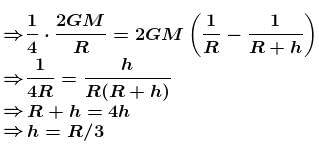Physics Exam > Physics Questions > Maximum height reached by a rocket fired with...
Start Learning for Free
Maximum height reached by a rocket fired with a speed equal to 50% of the escape velocity from earth’s surface is :
- a)R/2
- b)R/8
- c)16R/9
- d)R/3
Correct answer is option 'D'. Can you explain this answer?
| FREE This question is part of | Download PDF Attempt this Test |
Verified Answer
Maximum height reached by a rocket fired with a speed equal to 50% of ...

Applying energy conservation



The correct answer is: R/3



The correct answer is: R/3
Most Upvoted Answer
Maximum height reached by a rocket fired with a speed equal to 50% of ...
Escape Velocity:
Escape velocity from Earth's surface is the minimum speed needed for an object to break free from Earth's gravitational pull without any further propulsion. It is given by the formula:
\[v_e = \sqrt{\frac{2GM}{R}}\]
where \(G\) is the gravitational constant, \(M\) is the mass of the Earth, and \(R\) is the radius of the Earth.
Speed of the Rocket:
The rocket is fired with a speed equal to 50% of the escape velocity, which means its initial speed is:
\[v_i = \frac{1}{2}v_e = \frac{1}{2}\sqrt{\frac{2GM}{R}}\]
Maximum Height:
To find the maximum height reached by the rocket, we can use the energy conservation principle. At the maximum height, all of the initial kinetic energy is converted into potential energy. Therefore, we have:
\[\frac{1}{2}m(v_i)^2 = mgh\]
where \(m\) is the mass of the rocket, \(g\) is the acceleration due to gravity, and \(h\) is the maximum height.
Solving for Maximum Height:
Substituting the values of \(v_i\) and rearranging the equation, we get:
\[\frac{1}{2}\left(\frac{1}{2}\sqrt{\frac{2GM}{R}}\right)^2 = gh\]
\[\frac{1}{4}\frac{2GM}{R} = gh\]
\[h = \frac{1}{8}\frac{2GM}{R}\]
\[h = \frac{GM}{4R}\]
Therefore, the maximum height reached by the rocket fired with a speed equal to 50% of the escape velocity from Earth's surface is \(R/4\) or \(R/3\) (approximately), which corresponds to option 'D'.
Free Test
FREE
| Start Free Test |
Community Answer
Maximum height reached by a rocket fired with a speed equal to 50% of ...

Applying energy conservation



The correct answer is: R/3



The correct answer is: R/3

|
Explore Courses for Physics exam
|

|
Similar Physics Doubts
Maximum height reached by a rocket fired with a speed equal to 50% of the escape velocity from earth’s surface is :a)R/2b)R/8c)16R/9d)R/3Correct answer is option 'D'. Can you explain this answer?
Question Description
Maximum height reached by a rocket fired with a speed equal to 50% of the escape velocity from earth’s surface is :a)R/2b)R/8c)16R/9d)R/3Correct answer is option 'D'. Can you explain this answer? for Physics 2024 is part of Physics preparation. The Question and answers have been prepared according to the Physics exam syllabus. Information about Maximum height reached by a rocket fired with a speed equal to 50% of the escape velocity from earth’s surface is :a)R/2b)R/8c)16R/9d)R/3Correct answer is option 'D'. Can you explain this answer? covers all topics & solutions for Physics 2024 Exam. Find important definitions, questions, meanings, examples, exercises and tests below for Maximum height reached by a rocket fired with a speed equal to 50% of the escape velocity from earth’s surface is :a)R/2b)R/8c)16R/9d)R/3Correct answer is option 'D'. Can you explain this answer?.
Maximum height reached by a rocket fired with a speed equal to 50% of the escape velocity from earth’s surface is :a)R/2b)R/8c)16R/9d)R/3Correct answer is option 'D'. Can you explain this answer? for Physics 2024 is part of Physics preparation. The Question and answers have been prepared according to the Physics exam syllabus. Information about Maximum height reached by a rocket fired with a speed equal to 50% of the escape velocity from earth’s surface is :a)R/2b)R/8c)16R/9d)R/3Correct answer is option 'D'. Can you explain this answer? covers all topics & solutions for Physics 2024 Exam. Find important definitions, questions, meanings, examples, exercises and tests below for Maximum height reached by a rocket fired with a speed equal to 50% of the escape velocity from earth’s surface is :a)R/2b)R/8c)16R/9d)R/3Correct answer is option 'D'. Can you explain this answer?.
Solutions for Maximum height reached by a rocket fired with a speed equal to 50% of the escape velocity from earth’s surface is :a)R/2b)R/8c)16R/9d)R/3Correct answer is option 'D'. Can you explain this answer? in English & in Hindi are available as part of our courses for Physics.
Download more important topics, notes, lectures and mock test series for Physics Exam by signing up for free.
Here you can find the meaning of Maximum height reached by a rocket fired with a speed equal to 50% of the escape velocity from earth’s surface is :a)R/2b)R/8c)16R/9d)R/3Correct answer is option 'D'. Can you explain this answer? defined & explained in the simplest way possible. Besides giving the explanation of
Maximum height reached by a rocket fired with a speed equal to 50% of the escape velocity from earth’s surface is :a)R/2b)R/8c)16R/9d)R/3Correct answer is option 'D'. Can you explain this answer?, a detailed solution for Maximum height reached by a rocket fired with a speed equal to 50% of the escape velocity from earth’s surface is :a)R/2b)R/8c)16R/9d)R/3Correct answer is option 'D'. Can you explain this answer? has been provided alongside types of Maximum height reached by a rocket fired with a speed equal to 50% of the escape velocity from earth’s surface is :a)R/2b)R/8c)16R/9d)R/3Correct answer is option 'D'. Can you explain this answer? theory, EduRev gives you an
ample number of questions to practice Maximum height reached by a rocket fired with a speed equal to 50% of the escape velocity from earth’s surface is :a)R/2b)R/8c)16R/9d)R/3Correct answer is option 'D'. Can you explain this answer? tests, examples and also practice Physics tests.

|
Explore Courses for Physics exam
|

|
Suggested Free Tests
Signup for Free!
Signup to see your scores go up within 7 days! Learn & Practice with 1000+ FREE Notes, Videos & Tests.


















